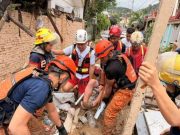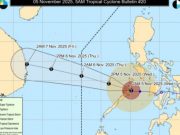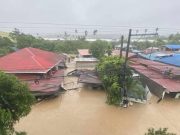At least three people were killed and nearly 400,000 others evacuated as Typhoon Kalmaegi (Philippine name Tino) unleashed devastating floods across the central Philippines, submerging entire towns and sweeping vehicles and shipping containers through streets, the country’s disaster agency said Tuesday.
The storm, known locally as Tino, made landfall early Tuesday and weakened as it tracked across the Visayas region, but sustained winds exceeded 80 mph (130 kph) while torrential rain triggered the worst flooding in memory for many residents.
“The situation in Cebu is really unprecedented,” provincial Gov. Pamela Baricuatro wrote on Facebook. “We were expecting the winds to be the dangerous part, but… the water is what’s truly putting our people at risk. The floodwaters are just devastating.”
Videos from Cebu City showed residents perched on rooftops as brown floodwaters surged below. Don del Rosario, 28, who took shelter on an upper floor, told Agence France-Presse it was the worst storm he had seen in his lifetime.
A Philippine Air Force rescue helicopter crashed Tuesday in northern Mindanao while supporting relief operations, the military said. Communication was lost with the aircraft near Agusan del Sur, prompting an immediate search and rescue mission. No information on survivors was available.
Rafaelito Alejandro, deputy administrator of the Office of Civil Defense, told reporters that almost 400,000 people had been preemptively moved from the typhoon’s path.
Kalmaegi is expected to exit into the South China Sea by Wednesday.
The Philippines averages 20 tropical cyclones annually. The latest storm struck just over a month after back-to-back typhoons killed more than a dozen people and damaged infrastructure and crops in late September and early October. An unusually wet monsoon earlier this year had already caused widespread flooding, fueling public anger over delayed and allegedly corrupt flood-control projects.
On Sept. 30, a 6.9-magnitude earthquake killed dozens and heavily damaged Cebu, compounding vulnerability to the current disaster.














